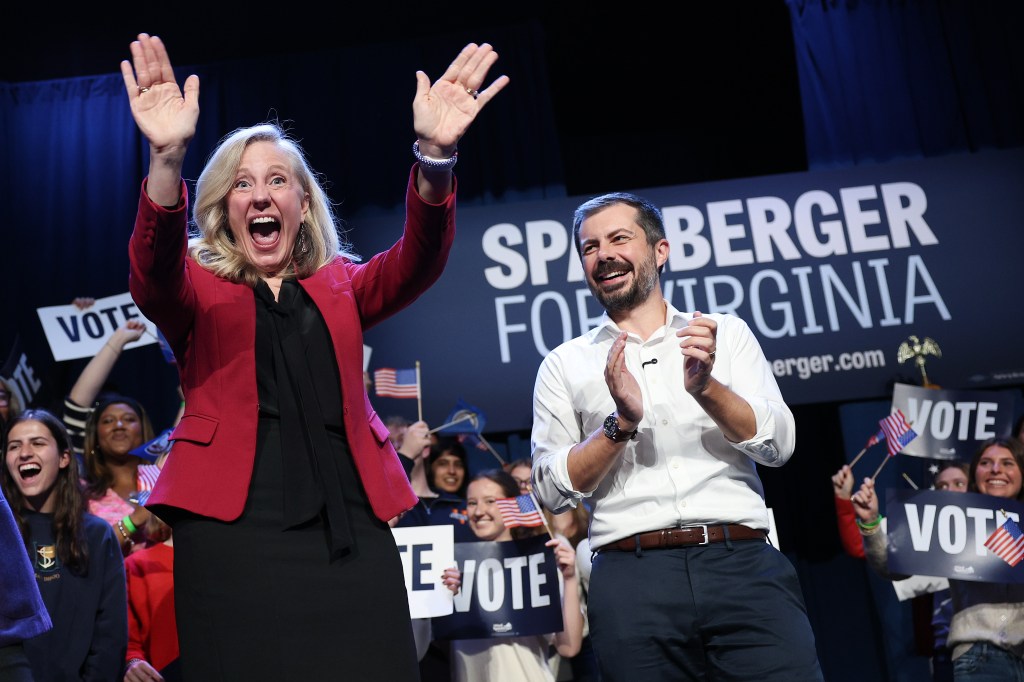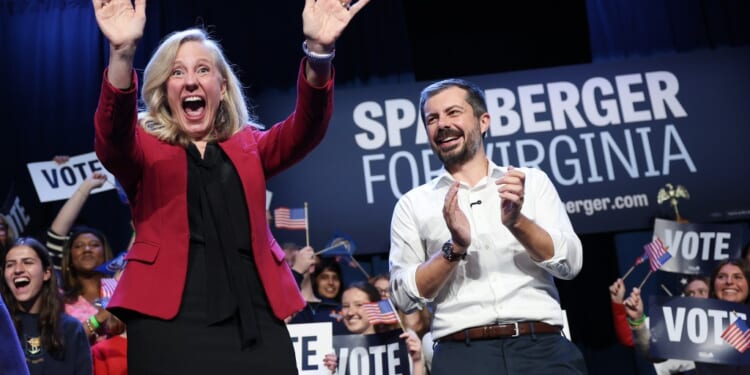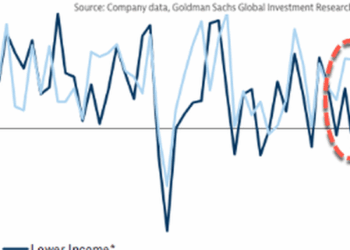
CHARLOTTESVILLE, Virginia—Several minutes before the Tuesday night rally for Abigail Spanberger began, a man on the public address system at the Jefferson Theater on Main Street implored the crowd to start cheering for the Democratic nominee for governor.
“Ab-i-GAIL! Ab-i-GAIL!” the disembodied voice prompted. The audience—made up primarily of over-60 college-town liberals—responded, their voices echoing throughout the tall, cavernous theater: “Ab-i-GAIL! Ab-i-GAIL! Ab-i-GAIL! Ab-i-GAIL!”
So it was a little awkward later on when, during an applause break about halfway through her speech, a handful of rallygoers attempted to start another round of “Ab-i-GAIL!” The crowd seemed unsure about joining in, the chant died abruptly, and Spanberger herself laughed from behind the lectern.
“It’s not a very good name for chanting, I will admit it,” said Spanberger, clasping her palms together as the audience laughed along with her. “But I appreciate it.”
Self-aware, self-deprecating, a little embarrassed by or uncomfortable with the performative aspects of politics—on an individual level, those traits make Spanberger endearing and relatable, almost normal. But in the reality of modern American politics, they reflect a possible limitation for Spanberger’s brand of staid, eggheady liberalism: Where’s the energy? Where’s the performance? Where’s the confidence?
Let me note this up front: Spanberger is well-positioned to win her race for governor on November 4, thanks in large part to the fundamentals of the race. She has outraised her Republican opponent, Lt. Gov. Winsome Earle-Sears, and has three times as much cash on hand. Polling indicates Spanberger leads Earle-Sears by a fairly comfortable margin. And it’s not just the so-called Virginia curse, where the commonwealth nearly always elects a governor from the opposite party of the incumbent president, working in Spanberger’s advantage. Donald Trump, who lost the state in all three of his White House runs, is still unpopular in Virginia, and his administration’s cuts to the federal workforce are felt acutely on this side of the Potomac.
This Spanberger rally, just down the road from Virginia’s elite flagship public university, also featured former Transportation Secretary (and McKinsey consultant and Rhodes scholar) Pete Buttigieg and Bill Nye, the longtime television personality known from his eponymous children’s educational show as “the Science Guy.” This was a gathering by and for the political rationalists, the modern-day goo-goos, the nerds.
That programming represents an important wing of the modern Democratic Party, responsible for its only two-term presidents of the last 70 years and for the vast majority of its major public policy successes during that period. Call it neoliberalism or center-left pragmatism or “abundance liberalism”—it’s an approach to liberal politics that appeals specifically to an upper-middle-class, educated set like those who showed up to see Spanberger in Charlottesville this week but, with the right champion, can have broader appeal to the rest of the Democratic base and beyond.
“Politics is about the air that we breathe, the schools that we attend, the roads that we drive on, the internet that we do or do not have, the electricity that is generating in our communities,” Spanberger put it Tuesday. “It’s about the opportunities that exist, the new housing that is or isn’t built. It’s about the health care that we have. Everything is political.”
For these Democrats, government is energetic but limited, used only for good to create equitable prosperity at home and careful stewardship of America’s hegemony abroad. It’s what used to be called the “politics of meaning” or “hope and change” in past eras. It imagines the public realm as active but in the background, working smartly and responsibly for the betterment of all. It’s the Democratic Party of Bill Clinton and Barack Obama and, perhaps, of Buttigieg.
(In Charlottesville this week, Buttigieg was clearly workshopping some lines for a potential 2028 stump speech, including a litany of complaints about the Trump administration, each of them followed by the mantra that “We can do so much better.”)
Whether it’s Buttigieg, or Pennsylvania Gov. Josh Shapiro, or someone else, the successor to Clinton and Obama will have to overcome not just a high charisma bar but also a confident left wing, where the energy of the Democratic Party truly resides. From Sen. Bernie Sanders to his political offspring like Rep. Alexandria Ocasio-Cortez and New York mayoral candidate Zohran Mamdani, the political left has a more compelling bench of captivating candidates than the moderate middle, despite the fact that recent elections seem to be a rebuke of lefty ideas on everything from crime and immigration to transgender policies. Meanwhile, on the right, Trump has reinvented the incentive structure for Republican political candidates to ape his performative approach to campaigning and governance and embrace “authenticity,” however crude or impolitic.
In his remarks Tuesday, Buttigieg gave voice to the nagging frustration many in his cohort may be feeling at this reality, where their ideas about incremental liberalism may be drowned out by the noise from either wing: “Just because you win a policy argument doesn’t mean you automatically get to win the election.”
If Spanberger’s likely victory is underwhelming or if she somehow loses running as a moderate Democrat in a Trump-averse state, what sort of future exists for this faction within the Democratic Party? It all has me thinking about one more moment of collective hesitation from Spanberger’s rally.
When Bill Nye, wearing a smart purple coat and his signature bow tie, came on stage, he told the crowd how he came to know the candidate: “I first heard about Abigail Spanberger after she famously explained to some Democratic Party operatives that they have to stop saying odd, strange, weird things, like ‘defund the police.’” Spanberger’s post-2020-election scolding of her party’s strategists was not only correct, it helped put her on the map as the most visible proponent of shedding the party of its most toxic slogans and turning the corner on its Trump-era leftward lurch.
The crowd in the Jefferson Theater briefly laughed and applauded at Nye’s recollection, then caught themselves. Were Democrats allowed to cheer about this? Was it really okay to admit that “defund the police” was a loser?
The progressive calls from half a decade ago to shift law enforcement funding to feel-good community policing programs may have failed to deliver the party big wins, but the nervousness in the crowd suggests the youthful passion of the upcoming generations may win out over political practicality. The sea of gray heads in Charlottesville are, of course, the prime customers for the kind of wonky reasonableness that Democrats like Spanberger and Buttigieg are selling. But these liberal boomers aren’t the future of the Democratic Party, so how can we expect the candidates they champion to tell us where things are headed?
Without the courage of their convictions and strong, charismatic leaders to defend them, the center-left seems destined to remain a junior partner in a minority party.

















